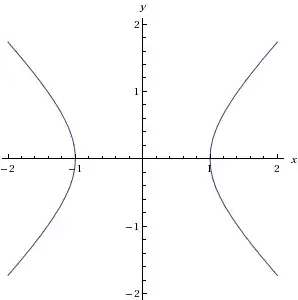First of all, if you want to draw a portion of the hyperbola, you typically just need parametric equations of the form $x = x(t)$, $y = y(t)$; you don't necessarily need to get $y$ as a function of $x$.
But, ignoring that quibble, I'll try to answer the question you asked.
The key is to first eliminate the $xy$ term in the implicit equation. In effect, you do this by rotating the coordinate system. This is really the same idea as Will Jagy used in his answer, but it might be easier to understand if I don't mention eigenvectors.
Suppose we introduce a $uv$ cooordinate system that is rotated by an angle $\theta$ (counterclockwise) from the $xy$ one. Then we have
$$x = u\cos\theta - v\sin\theta \quad ; \quad y = u\sin\theta + v\cos\theta$$
You can plug these $x$ and $y$ expressions into your original equation, and you'll get
$$\bar A u^2 + \bar B uv + \bar C v^2 + \bar Du + \bar Ev + \bar F = 0 $$
where
$$\bar A = A \cos^2\theta + 2B \sin \theta\cos\theta + C \sin^2\theta $$
$$\bar B = 2 B \cos 2\theta - (A - C) \sin 2\theta $$
$$\bar C = A \sin^2\theta - 2B \sin\theta\cos\theta + C \cos^2\theta $$
and so on. Now we just have to cleverly choose $\theta$ so that the $uv$ term disappears. Clearly, we'll get what we want if we choose $\theta$ so that $\bar B = 0$, and this means
$$ \tan2\theta = \frac{2B}{A - C}$$
After using this technique, we can now assume that the equation has the form
$$a u^2 + c v^2 - 2adu - 2cev + f = 0 $$
Note that I'm using $-2ad$ in place of $\bar D$ and $-2ce$ in place of $\bar E$, just to make the next step more convenient. And the next step is just some "complete the square" tricks. The equation can be written:
$$a (u^2 - 2du) + c (v^2 - 2ev) + f = 0 $$
In other words:
$$a (u^2 - 2du + d^2) + c (v^2 - 2ev + e^2) + f - ad^2 - ce^2 = 0 $$
which is
$$a (u - d)^2 + c (v - e)^2 = ad^2 + ce^2 - f $$
Now it should be clear that we have either an ellipse (if the signs of $a$ and $c$ are the same) or a hyperbola (if the signs are different). I'm ignoring the parabola case and several degenerate cases. The ellipse/hyperbola has its center at the point $(d,e)$ in the $uv$ coordinate system, and its axes of symmetry are parallel to the $u$ and $v$ axes.
At this point, if our curve turns out to be a hyperbola, you can use standard parametric equations (like the ones Wil Jagy gave) to trace out one branch or the other.

